Terry L. Ettinger Horticulture Consulting Services
Meeting The Needs Of Today With A Vision For The Future
Special Topics
Evergreen Identification
Falsecypress (Chamaecyparis)
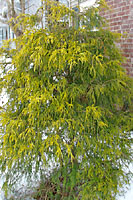 Less common than arborvitae, though not at all uncommon in Central New York landscapes are numerous cultivars of the
Hinoki, Nootka, and Japanese threadleaf falsecypress. However, because of their wide range of growth habits and leaf forms,
they can be a bit tricky to tell apart from arborvitae and some junipers.
Less common than arborvitae, though not at all uncommon in Central New York landscapes are numerous cultivars of the
Hinoki, Nootka, and Japanese threadleaf falsecypress. However, because of their wide range of growth habits and leaf forms,
they can be a bit tricky to tell apart from arborvitae and some junipers.
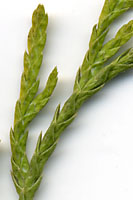 The green and yellow-green leafed cultivars of the threadleaf falsecypress (Chamaecyparis pisifera `Filifera’
and C. pisifera `Filifera Aurea,’ respectively) are probably the most frequently planted falsecypress in Central
New York (at right, above). Their slightly spreading and pointed leaves,
at left, cause them to often be incorrectly identified as junipers. However,
their long, thread-like stems lack the sharply-pointed, awl-shaped leaves that make junipers so prickly!
The green and yellow-green leafed cultivars of the threadleaf falsecypress (Chamaecyparis pisifera `Filifera’
and C. pisifera `Filifera Aurea,’ respectively) are probably the most frequently planted falsecypress in Central
New York (at right, above). Their slightly spreading and pointed leaves,
at left, cause them to often be incorrectly identified as junipers. However,
their long, thread-like stems lack the sharply-pointed, awl-shaped leaves that make junipers so prickly!
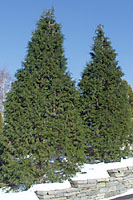 Meanwhile, many Hinoki falsecypress (C. obtusa) cultivars,
at right, look a lot like our native arborvitae. Like arborvitae,
their leaves are tightly compressed upon one another, though not nearly as flattened in cross-section. They also lack the
glands often found just below the tips of arborvitae
Meanwhile, many Hinoki falsecypress (C. obtusa) cultivars,
at right, look a lot like our native arborvitae. Like arborvitae,
their leaves are tightly compressed upon one another, though not nearly as flattened in cross-section. They also lack the
glands often found just below the tips of arborvitae
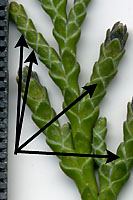 leaves. And, if you look very closely, you’ll often see what appears to
be numerous white “X”-shaped markings created by accumulations of wax along the edges of each leaf
(arrows in photo at left).
leaves. And, if you look very closely, you’ll often see what appears to
be numerous white “X”-shaped markings created by accumulations of wax along the edges of each leaf
(arrows in photo at left).
As testament to the variability of this species, one Boring, Oregon nursery lists 34 different cultivars!
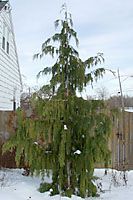 A third increasingly common falsecypress is the weeping form of Nootka falsecypress, C. nootkatensis `Pendula,’
below.
It’s leaves tend not to be as tightly as compressed as those of Hinoki falsecypress, nor as long and pointed as threadleaf
falsecypress.
A third increasingly common falsecypress is the weeping form of Nootka falsecypress, C. nootkatensis `Pendula,’
below.
It’s leaves tend not to be as tightly as compressed as those of Hinoki falsecypress, nor as long and pointed as threadleaf
falsecypress.